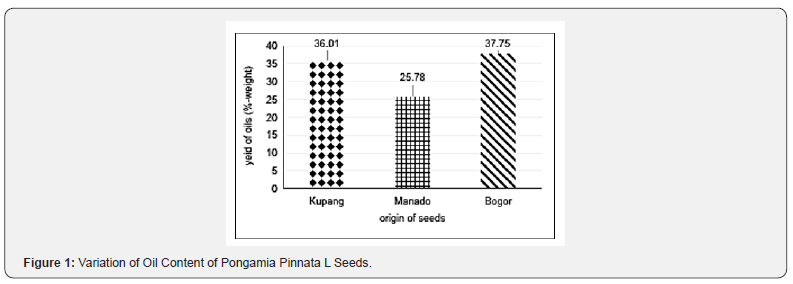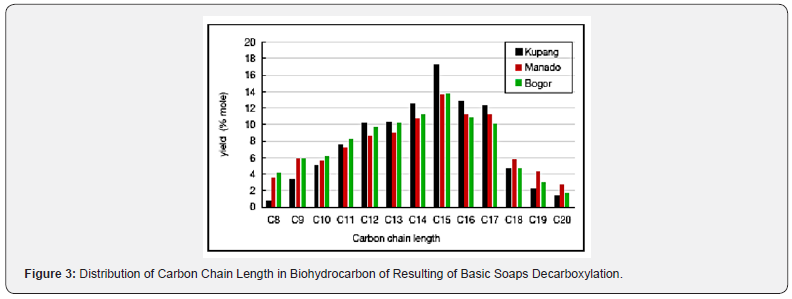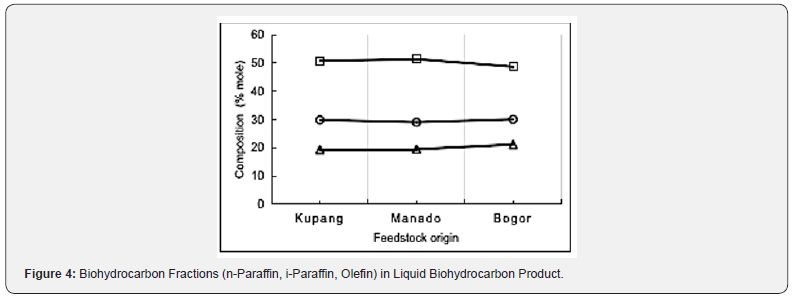Juniper Online Journal Material Science - Juniper Publishers
Abstract
The objective of this work is to investigate the influence of the origin of Pongamia pinnata L. seed oil on the structure and composition of triglyceride or fatty acids and liquid bio-hydrocarbons. In this study, Pongamia pinnata L. seed oil was collected from three different locations in Indonesia, namely Kupang (West Timor), Manado (North Sulawesi) and Bogor (West Java). Through the metathesis method, the oils were converted to basic soaps with a mixture of magnesium and zinc metal compounds. Furthermore, the basic soaps were decarboxylated to produce liquid biohydrocarbon fuel. The oil content, fatty acid composition and liquid biohydrocarbon fraction had been analyzed through a series of experiments. It was found that the oil of Pongamia pinnata L. seed taken from different areas resulted in a variety of fatty acids’ composition. The composition of palmitic, stearic, oleic and linoleic fatty acids were different for each location; the seed oil derived from Kupang were 17.02, 8.40, 30.05 and 17.40% mole, the Bogor’s oil were 11.87, 4.66, 23.41 and 11.40% mole, and Manado’s oil were 15.15, 5.11, 31.93 and 11.22% mole, respectively.
Keywords: Pongamia pinnata seed oil; Liquid biohydrocarbons; Decarboxylation; Basic soap
Introduction
Nowadays, many researchers are interested to find renewable liquid drop-in fuels in view of its enormous economic, social and environmental benefits [1]. That is because fossil fuels are limited, and will be depleted in the near future [2], while its demand continues to increase [3]. For these reasons, many researchers are interested to investigate the various sources of vegetable oil to be processed into renewable liquid drop-in fuels such as green diesel, green jet fuel and green gasoline. Vegetable oils which are specifically for the manufacture of renewable liquid fuels are better derived from non-edible sources, which are widespread in Indonesia. Pongamia pinnata L. is known as one of the non-edible oil producing plants whose growth is widespread in various regions in Indonesia.
Pongamia pinnata L. is an oil seed tree species [4], which produces seeds rich in oil and is easily convertible into diesel fuel (e.g. bio-diesel) meeting international standards [5]. The trees is an important nonedible minor oilseed tree that grows in the semiarid regions [6]. Mature seeds of Pongamia pinnata L. contains about 28-40% oils [7] which can be converted to fuel for conventional diesel engines. At present, the oil of Pongamia pinnata L. seed is being explored mainly for its use as bio-diesel. The potential of Pongamia pinnata L. seed oil as a source of fuel for the biodiesel industry is well recognized [8]. However, the use of biodiesel as a fuel for conventional diesel engines is limited up to 20% only (B20) because it is oxygenate fuel.
To increase the use value of oil of Pongamia pinnata L. seed, it is best to convert the oil to produce drop-in liquid fuels (e.g. green diesel). The drop-in fuel can be used higher than 20 to 100% to be blended in the fossil fuel by this method. One method to produce the drop-in fuel is through basic soaps thermal decarboxylation. In this method, the oil is converted to produce the basic soaps, then the soaps are decarboxylated to produce liquid bio-hydrocarbons (drop-in fuel). In our previous research, it has been found that magnesium-sinc metal compounds mixture is excellent to prepare decarboxylation process feed soaps derived from palm oils [9]. In the case of the production of diesel-type liquid fuels, vegetable oil (e.g. Pongamia pinnata L. is preferable because it contains more palmitic (16:0), staerate (18:0) and oleic (18:1) acids. However, there are technical and informative challenges about data of potential and production of Pongamia pinnata L. seed oil in Indonesia. The technical challenges has mentioned above involved the identification and development of Pongamia pinnata L. plant which may resulted in more seed oil with a composition of fatty acids suitable for the production of certain renewable liquid fuels.
The content of vegetable oil (in seed) such as triglyceride structure and fatty acid composition are influenced by the area of growth (especially soil type and climatic factor) or the origin of the parent plant [10]. Meanwhile, it is well known that fatty acid composition of the feedstock (seed oil) can directly influence the type and quality of produced fuel [11]. Asomaning et al. [12] has reported that product composition and distribution of liquid fuel fraction of fat and oil (include its derivative) decarboxylation depends on the source of the fat or oil. Some data that has been reported above, suggesting that there are differences in oil content and possibly the fatty acid content of Pongamia pinnata L seeds which grow in one area with other regions as well. In particular, the differences in fatty acid content have implications for the types of renewable liquid fuels produced for transportation. However, no research data has been found on the identification and evaluation of oil and the composition of fatty acids contained in Pongamia pinnata L. seeds in Indonesia, and its development to produce renewable liquid fuels, especially drop-in types. The objectives of this work are analyzed oil content, the structure and composition of triglycerides or fatty acids and its liquid bio-hydrocarbons (drop-in fuels) of Pongamia pinnata L. seed from different areas in Indonesia (Kupang, Manado and Bogor). This research is expected to result specific data about Pongamia pinnata L. seed oil in Indonesia and its implications for making of renewable liquid fuels. Thus, these data become the sources to determine the type of fuel that is suitable for the profile of the fatty acid composition in the oil.
Materials and Methods
Seeds of pongamia pinnata L. was collected from several locations in Indonesia, namely Manado, Bogor and Kupang. Soxhlet apparatus was used to extract the oils from pongamia pinnata seeds. Petroleum ether was used as solvent to extraction. The following equation were used to calculate the yield:
Yield (wt%) = p/s x 100
where p = mass of pongamia pinnata oil (g); s = mass of kernel (sample) before extraction.
Pongamia pinnata seed oil methyl esters (PPME) were prepared following a standard procedure of two-step transesterification by methanol using catalyst sodium hydroxide [13]. Basic soap derived from Pongamia pinnata oil was pepared with Double Decomposition method. Decarboxylation of the basic soap was carried out at 370oC and atmospheric pressure for six hours in a semi batch reactor to produce biohydrocarbons.
GC-MS analysis of PPME and liquid hydrocarbons product was performed using a Perkin–Elmer GC Clarus 500 system comprising an AOC-20i auto-sampler and a Gas Chromatograph interfaced to a Mass Spectrometer (GC-MS) equipped with a Elite- 5MS (5% diphenyl/95% dimethyl poly siloxane) fused a capillary column (30×0.25μm ID × 0.25μm df). For GC-MS detection, an electron ionization system was operated in electron impact mode with an ionization energy of 70eV. Helium gas (99.999%) was used as a carrier gas at a constant flow rate of 1ml/min, and an injection volume of 2μl was employed (a split ratio of 10:1). The injector temperature was maintained at 250°C, the ion-source temperature was 200°C, the oven temperature was programmed from 110°C (isothermal for 2 min), with an increase of 10°C/min to 200°C, then 5°C/min to 280°C, ending with a 9 min isothermal at 280°C. Mass spectra were taken at 70eV; a scan interval of 0.5s and fragments from 45 to 450 Days. The solvent delay was 0 to 2min, and the total GC/MS running time was 36min. The relative percentage amount of each component was calculated by comparing its average peak area to the total areas
Results and Discussion
Based on experimental results, it was found that the oil content of Pongamia pinnata L. seeds varies between the all three origin areas. The oil content of seed for each area was shown in Figure 1. It was found that, approximately 37.75% oil was produced by seeds originated from Bogor; it was more than Kupang (36.01%) and Manado (25.78%). These variations reflect the difference in the environmental factors that influence seed oil content.
This difference in the oil content of the seeds is possibly appear as a consequence of differences in soil types and climatic factors [10] in all three areas of growth. According to Jain [14] the fatty acid composition as well as oil content in most oil crops are influenced by a combination of genetic and environmental factors. In addition, variations in oil content may be due to differences in seed maturity at harvest time. With respect to the influence of maturity level, Slack and Brows [15] reports that oil content in developing seeds varies with maturity. However, in this study there were no scientific data and in-depth investigations carried out previously to determine the level of maturity of the seeds from the time of flowering. It is due to the fact that, currently there have been no regular cultivation and observations on Pongamia pinnata L. plants. Therefore, the seeds were collected from wildly growing plants.
The fatty acid composition in oils of Pongamia pinnata L. seed showed different profile (Figure 2) depending on their own origin. These differences most likely emerge due to differences in seed growth rate [11] generated by Pongamia pinnata L. plants in their own origin. Environmental factors may modify the fatty acid pattern of plant. Thus, the seed oils of plants grown in cool climates tend to be more unsaturated than those grown in warm climates [16]. In general, seed oil from all three areas contain chiefly fatty acids having 16 to 24 carbon atoms per molecule. Experimental result shows that total unsaturated fatty acids (18:1 and 18:2) present in oil of Pongamia pinnata L. seed originated from Kupang was 47,45%, which was higher than Manado (44,44%) and Bogor (34,87%). Similarly, saturated fatty acids, mainly stearic (18:0) and palmitic (16:0) present in Kupang (25.42%) was also higher than Manado (20.26 %) and Bogor (16.53 %). In the case of C18 fatty acid composition, the oil of Pongamia pinnata L. seed originated from Kupang contained higher amount of unsaturated fatty acid compared to saturated fatty acids. However, the oil of seed originated from Manado contained higher amount of mono unsaturated fatty acid (18:1).


The presence of differences in saturated and unsaturated fatty acid composition in oil of pongamia pinnata L. seeds likely led to variations in the quality of the yielded bio-hydrocarbon (dropin) fuels. In terms of diesel fuel production, the most important essential fatty acids are palmitic (16:0), stearic (18:0) and oleic (18:1). Oleic acid is regarded as an important source of diesel fuel production because it produces fuel with low cloud point. On the other hand, stearic and palmitic acids are known to increase the cloud point because these molecules have low mobility. Furthermore, polyunsaturated fatty acids i.e. linoleic (18:2) and linolenic (18:3) are less expected in fuel because they can lead to oxidation reactions [8].
The fatty acid profiles determine the quality and carbon chain length distribution of the resultant liquid bio-hydrocarbon. Decarboxylation of basic soaps derived from Pongamia pinnata L. seed oil of all three areas, was carried out at 370°C for 5 hours in a semi-batch reactor. The reaction product is a mixture of paraffin (normal- and iso-paraffin) and olefins fractions in the ranges of carbon chain length C8 to C20. The carbon chain length distribution of liquid bio-hydrocarbons is shown in Figure 3. Specifically for bio-hydrocarbon molecule with C12-C17 chain length, it was produced more by decarboxylation of basic soaps from Pongamia pinnata L. seed oil originated from Kupang than Bogor and Manado, respectively. The most important carbon chain length for green diesel fuel are C14 to C18. Therefore, the liquid biohydrocarbon (green diesel) produced by decarboxylation of basic soaps derived from Pongamia pinnata L. seed oil originated from Kupang is better than Bogor and Manado. Liquid bio-hydrocarbon product based on the oil extracted of Pongamia pinnata L. seed originated from Manado seemed to have slightly higher isoparaffin (51.45%) than Kupang (50.78%) and Bogor (48.71%). Grouping of liquid bio-hydrocarbon products according to the hydrocarbon fraction is shown in Figure 4.


Specifically, total paraffin (n- and i-paraffin) were found slightly higher in liquid bio-hydrocarbon product produced by decarboxylation of basic soaps based on Pongamia pinnata L. seed oils originated from Kupang (80.65%) than Manado (80.51%) and Bogor (78.79%). High n-paraffin content can increase cetane numbers, whereas, high iso-paraffins can produce good cold flow properties [17]. Olefin fraction was the highest in liquid bio-hydrocarbon based on the oil extracted of seed originated from Bogor, with the highest value was 21.18, which was higher % than Kupang (19.34%) and Manado (19.49%). The liquid biohydrocarbon based on seed oil of all three areas exhibited the least variation in normal paraffin fraction. The saturated fatty acid was found to associate positively with paraffin fraction.
Therefore, to produce liquid bio-hydrocarbons with high paraffin fraction, the oils should have high content of saturated fatty acids as well. The oil with highly unsaturated fatty acid content tends to produce short chain bio-hydrocarbons (<10). This is likely due to the presence of the breaking of the carbon chains of the liquid bio-hydrocarbon molecule on the carbon bonds around the double bond, when decarboxylation takes place on the basic soaps.
Conclusion
The oil content appeared to be higher in Pongamia pinnata L. seeds originated from Bogor (37.75% weight), although it was only slightly higher than Kupang (36.01% weight). Fatty acid composition of the oils of all three Pongamia pinnata seeds appeared to be dominated by palmitic, oleic and linoleic acids. Higher content of mono unsaturated fatty acid was resulted by oil of Pongamia pinnata L. seed from Manado (31.93% mole).
Decarboxylation of basic soaps derived from Pongamia pinnata L. seed oils originated from Bogor resulted in slightly higher olefin (21.18% mole) fractions. The oil of Pongamia pinnata L. seed originated from Kupang contained more palmitic (17.02% mole) and stearic (8.40% mole) fatty acids, therefore, it is better to be used as feedstock to produce green diesel fuel. Pentadecane composition (n-C15) that was most generated in liquid biohydrocarbon by decarboxylation of basic soaps based on seed oil was originated from Kupang area. Acording to all above results, the origin of Pongamia pinnata L. seed strongly influences the oil content, fatty acid composition, carbons chain length and biohydrocarbon fraction in drop-in fuel.
To Know more about Juniper Online Journal Material Science
To Know more about Juniper Online Journal Material Science
Click here: https://juniperpublishers.com/jojms/index.php
To Know more about our Juniper PublishersClick here: https://juniperpublishers.com/index.php
Click here: https://juniperpublishers.com/jojms/index.php
Click here: https://juniperpublishers.com/index.php





There is a safe & effective Natural Herbal Medicine. For Total Cure Call +2349010754824, or email him drrealakhigbe@gmail.com For an Appointment with (Dr.) AKHIGBE contact him. Treatment with Natural Herbal Cure. For:Dengue Fever, Malaria. Painful or Irregular Menstruation. HIV/Aids. Diabetics. Vaginal Infections. Vaginal Discharge. Itching Of the Private Part. Breast Infection. Discharge from Breast. Breast Pain & Itching. Lower Abdominal Pain. No Periods or Periods Suddenly Stop. Women Sexual Problems. High Blood Pressure Chronic Disease. Pain during Sex inside the Pelvis. Pain during Urination. Pelvic Inflammatory Disease, (PID). Dripping Of Sperm from the Vagina As Well As for Low sperm count. Parkinson disease. Obesity, Lupus. Soreness/Injury Cancer. Tuberculosis. Zero sperm count. Bacteria, Impotence Fertility,Protoplasmic, Diarrhea. Hepatitis A&B, Rabies. Asthma. Quick Ejaculation. Gallstone, Cystic Fibrosis, Schizophrenia, Crubs, Cirrhosis, Premature Ejaculation. Herpes. Joint Pain. Stroke. Cornelia Disease, Weak Erection. Ovarian problem, HeartBurn, Erysipelas, Thyroid, Relapsing polychondritis, Discharge from Penis. Bronchial Problem, HPV. Hepatitis A and B. STD. Smallpox, Staphylococcus + Gonorrhea + Syphilis. Heart Disease. Pile-Hemorrhoid.rheumatism, Impotence, thyroid, Autism, Depression, Sepsis Bacteria, Penis enlargement, Prostate Problem, Waist & Back Pain. Male Infertility and Female Infertility. Etc. Take Action Now. contact him & Order for your Natural Herbal Medicine: +2349010754824 and email him drrealakhigbe@gmail.com Note For an Appointment with (Dr.) AKHIGBE.I suffered in Cancer for a year and three months dying in pain and full of heartbreak. One day I was searching through the internet and I came across a testimony of herpes cure by doctor Akhigbe. So I contacted him to try my luck, we talked and he sent me the medicine through courier service and with instructions on how to be drinking it.To my greatest surprise drinking the herbal medicine within three weeks I got the changes and I was cured totally. I don't really know how it happens but there is power in Dr Akhigbe herbal medicine. He is a good herbalist doctor.
ReplyDelete